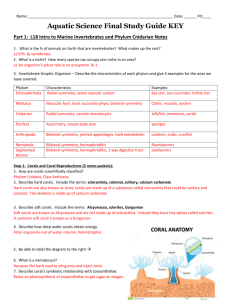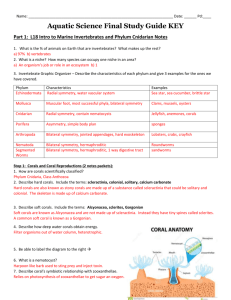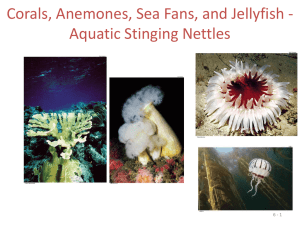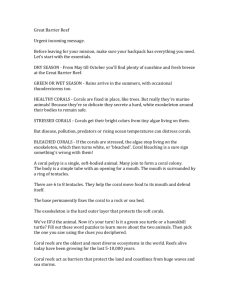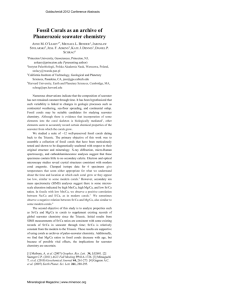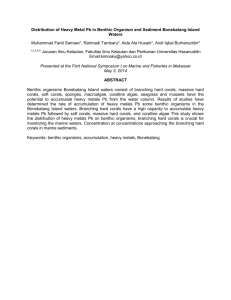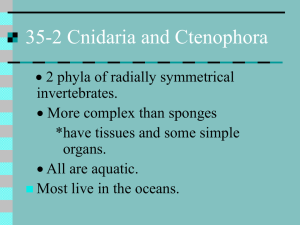Final Review Study Guide Key
advertisement
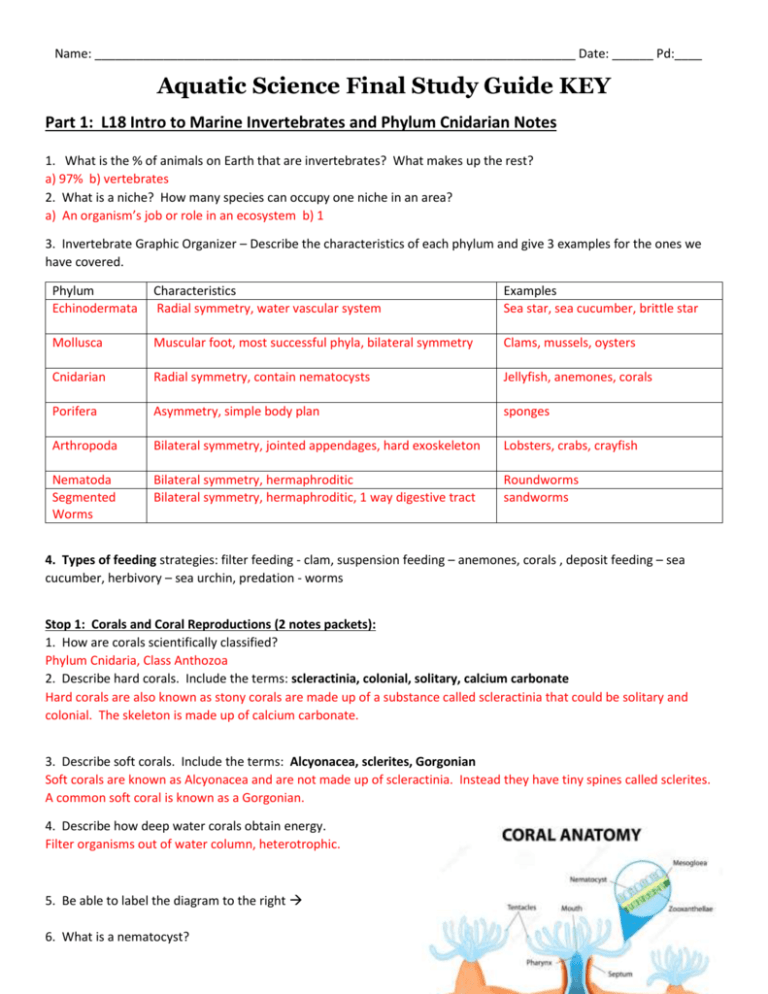
Name: ______________________________________________________________________ Date: ______ Pd:____ Aquatic Science Final Study Guide KEY Part 1: L18 Intro to Marine Invertebrates and Phylum Cnidarian Notes 1. What is the % of animals on Earth that are invertebrates? What makes up the rest? a) 97% b) vertebrates 2. What is a niche? How many species can occupy one niche in an area? a) An organism’s job or role in an ecosystem b) 1 3. Invertebrate Graphic Organizer – Describe the characteristics of each phylum and give 3 examples for the ones we have covered. Phylum Echinodermata Characteristics Radial symmetry, water vascular system Examples Sea star, sea cucumber, brittle star Mollusca Muscular foot, most successful phyla, bilateral symmetry Clams, mussels, oysters Cnidarian Radial symmetry, contain nematocysts Jellyfish, anemones, corals Porifera Asymmetry, simple body plan sponges Arthropoda Bilateral symmetry, jointed appendages, hard exoskeleton Lobsters, crabs, crayfish Nematoda Segmented Worms Bilateral symmetry, hermaphroditic Bilateral symmetry, hermaphroditic, 1 way digestive tract Roundworms sandworms 4. Types of feeding strategies: filter feeding - clam, suspension feeding – anemones, corals , deposit feeding – sea cucumber, herbivory – sea urchin, predation - worms Stop 1: Corals and Coral Reproductions (2 notes packets): 1. How are corals scientifically classified? Phylum Cnidaria, Class Anthozoa 2. Describe hard corals. Include the terms: scleractinia, colonial, solitary, calcium carbonate Hard corals are also known as stony corals are made up of a substance called scleractinia that could be solitary and colonial. The skeleton is made up of calcium carbonate. 3. Describe soft corals. Include the terms: Alcyonacea, sclerites, Gorgonian Soft corals are known as Alcyonacea and are not made up of scleractinia. Instead they have tiny spines called sclerites. A common soft coral is known as a Gorgonian. 4. Describe how deep water corals obtain energy. Filter organisms out of water column, heterotrophic. 5. Be able to label the diagram to the right 6. What is a nematocyst? Harpoon like barb used to sting prey and inject toxin. 7. Describe coral’s symbiotic relationship with zooxanthellae. Relies on photosynthesis of zooxanthellae to get sugar an oxygen. 8. What are the 2 methods by which corals can reproduce? asexually and sexually 9. Draw the basic life cycle of coral in the space below. Which stage does coral spend most of its life in? Polyp stage 10. What is the dominant way corals reproduce? Broadcast spawning 11. Describe the life cycle of a coral. Release sperm and egg into water column, sperm and egg join – fertilization, which forms planula larva, settles into polyp stage Stop 2: Jellyfish Notes Packet 1. What are the 3 classes of jellyfishes? Include what types of jellies belong to each class. a. Hydrozoa – Obelia and portugese man of war b. Scyphozoa – Common jellyfish c. Cubozoa – Box jellyfish 2. a. What are cnidocytes? Cells that contain nematocysts. b. Nematocysts? Harpoon like filament with barbs that is released to inject poison into prey. 3. What type of symmetry to jellyfish exhibit? radial 4. Describe the process by which jellyfish deploy their “stingers” to stun their prey. Stinger cells triggered, internal pressure massive 2000 PSI, bursts firing out a toxin harpoon. Goes from coiled to uncoiled to stun and inject toxin into prey. Stop 3: Anemones Notes Packet 1. What is the scientific classification of sea anemones? Phylum Cnidaria, Class Anthozoa 2. What anatomical structure helps anemones attach to its substrate? Pedal disc 3. What type of toxin do anemones inject into their prey? neurotoxin 4. What benefit does green algae provide for anemones? Does photosynthesis, so provides glucose and oxygen. 5. What type of relationship do anemones and clownfish exhibit? mutualistic 7. Which life cycle stage do anemones spend the majority of their lives in? polyp Matching Review: Part 1 1. E_____ Suspension Feeding 2. G_____ Deposit Feeding 3. F_____ Filter Feeding 4. I____ Predation 5. H_____ Herbivory 6. A_____ Niche 7. B_____ Morphology 8. C_____ Anatomy 9. D_____ Physiology 10. J____ Invertebrate a. Role within an ecosystem b. Study of structure of organisms c. Study of structure of animals d. Study of processes within organisms e. Type of filter feeding in which organisms do not create their own currents f. Type of feeding where the animal pumps water through its body to remove food g. Feeding method where animals eat detritus h. Eating only plants and algae i. Animals that feed on other animals j. Organism that lack backbones Part 2 – a. Corals border island at a greater distance, with deep lagoon between itself and island b. Small, isolated piece of reef that grow on bottom c. Submerged island with coral continuously growing around it. d. Coral projects seaward directly from shore (most common) e. Cell that houses harpoon-like stinging mechanism f. Harpoon-like stinging mechanism that has barbs and delivers toxins to prey g. Photosynthetic algae that lives within corals h. Soft corals i. Hard corals j. Substance that makes up the skeletons of hard corals 1. D _____ Fringing Reef 2. A_____ Barrier Reef 3. B_____ Patch Reef 4. C_____ Atoll 5. I_____ Scleractinia 6. H_____ Alcyonacea 7. F_____ Nematocyst 8. E_____ Cnidocyte 9. G_____ Zooxanthallae 10.J ____ Calcium Carbonate Part 3 1. G_____ Scyphozoa 2. I_____ Hydrozoa 3. B_____ Cubozoa 4. J_____ Anthozoa 5. D_____ Ectoderm 6. C_____ Endoderm 7. E_____ Mesoglea 8. F_____ Nerve Net 9. A_____ Medusa 10. H____ Polyp a. Adult stage of jellyfish b. Class containing box jellyfish c. Inner layer of jellyfish d. Outer layer of jellyfish e. Gelatinous layer between endo and ectoderm f. System of basic receptors that transmit impulses throughout a jellyfish g. Class containing common jellyfish h. Juvenile stage of jellyfish i. Class containing Obelia and Portugese Man-of-War j. Class containing corals and anemones Part 2: Phylum Arthropoda 1. What does arthropod mean? Jointed appendage 2. What does it mean by saying Arthropods are protostomes? During embryonic develop, body cavity opening forms into mouth first. 3. Arthropods are cephalized, what does this mean? Have a distinct head. 4. What type of circulatory system do arthropods have? open 5. What is another word for molting? ecdysis 6. What subphyla do shrimp, lobsters, copepods, and barnacles belong to? Crustacea 7. Which subphyla do horsheshoe crabs belong to? Chelicerata 8. What are chelicerae? Claws or fangs 9. What are pedipalps used for? Swimming, walking, sensing 10. Compare the number of jointed appendages found in Chelicerata vs. Crustacea. 6 vs. 10 11. What is a cephalothorax? A fused head and thorax 11. Label the following diagram of a crayfish: Part 3: Phylum Echinodermata 1. What does echinoderm mean? Spiny -skinned 2. What is their endoskeleton made up of? ossicles 3. What is their larval stage known as? Bipinnaria or dipleurula 4. What type of symmetry do the adults exhibit? pentaradial 5. Label the aboral and oral side of the following diagram: 6. Why are echinoderms deuterostomes? Blastopore becomes anus (mouth forms second) 7. Describe the pathway of water through the water vascular system. Include the structures it passes through. madreporite stone canal ring canal radial canal ampulla tube feet Ms.RRat (I comes after a for the 2 R’s) 8. Which is the largest class of echinoderms? Ophiuroidea 9. What anatomical structure do sea urchins use to feed? Aristotle’s Lantern 10. Why type of symmetry do sea cucumbers exhibit? bilateral 11. Label the following diagrams with the class it belongs to: b. Crinoidea a. Echinoidea c. Holothuroidea d. Asteroidea e. Ophiuroidea Part 4: Phylum Mollusca 1. What type of feeders are bivalves (clams, mussels, oysters)? Active filter feeder 2. What is the free-living larval form of mollusks called? trocophore 3. Which class of mollusks contains the most intelligent organisms? cephalopoda Give an example of a very intelligent mollusk: cuttlefish 4. What does this intelligent class use to feed? _radula______________ and _____beak______________ 5. What are chromatophores? Cells in the skin that help camouflage the organism 6. Describe the few details I gave you about Class Polyplacophora. __Organism with 8 over-lapping hard plates._________________________________________ __________________________________________________________________________________________________ 7. What class do snails and slugs belong to? __Gastropoda________________________________ 8. Why are members of this class (from #10) called univalves? __Have one shell________________________________ 9. Why is Phylum Mollusca the most ecologically important phyla to humans? ___Used for food consumption, therefore generate jobs like fisheries, harvesting, testing, distribution, and obviously food sales. _________________________________________________________________________________________ 10. Do bivalves exhibit cephalization? _NO_________ Part 5 - Lesson 19: Biology of Fishes 1. What are the 3 major classes of fish? a. jawless fish b. bony fish c. cartilaginous fish 2. What are 2 examples of jawless fishes? a. hagfish b. lamprey 3. Describe how fish breathe. Include mouth, gills, and operculum. Fish swallow water, water passes over gills and out past operculum which absorbs oxygen from water. 4. Describe the function of each fin. 1) Caudal - _propulsion (forward movement)_______________________________ 2) Pelvic - ___stability___________________________________ 3) Anal - ____stability___________________________________ 4) Dorsal - stability – specifically keeps the organism from rolling over 5) Pectoral - ___lift and stability, steering_______________________________ 5. Write the feeding type that is best associated with the fish mouth structure shown next to the picture. (Use your book) a. small mouth nibbles on coral b. e. terminal ab. up-pointing sub-terminal feeds on prey below it feeds on prey above it open water feeder c. strong jaw preys on other fish ac. sucker-shaped blood sucking d. large mouth surrounds its prey 6. Next to each image, write how the pattern of coloration influences the organism’s niche. a. d. warning coloration warns prey its poisonous b. eyespots moves predators focus to wrong end, so it can escape e. red in color found in dark or dimlit areas mottled blends in with sandy bottoms c. f. disruptive breaks up its outline, helps blend with background counter shading blends in from top down with dark bottom background, and from bottom up with sky behind 7. Write the structures of each letter representing a fish’s anatomy. a. eye b. Lateral line c. Dorsal fin d. e. Caudal fin Anal fin f. pectoral fin g. pelvic fin h. operculum i. mouth 8. What is the balloon structure filled with air near the stomach and intestine? swim bladder 9. How does a fish use this structure to move up and down in the water column? (think about making yourself sink or float in a body of water – how can you regulate air your lungs to change your vertical position) contracts muscles around swim bladder to deflate. 10. What is the lateral line organ? Detects vibration in the water 11. What’s the difference between a skate and a stingray? Skate has 2 lobed fins and no barb on its tail. Skates oviparous – lays eggs outside the body Stingray – Ovoviparous eggs in the womb that give rise to live births 12. What part of cartilaginous fishes is preserved in the fossil record? Enameloid and dentine These next two questions should have been in Part 6 Marine Mammals (sorry!) 13. What is the proper term for “tail” when referring to marine mammals? fluke 14. What is the proper term for “mouth” when referring to marine mammals? rostrum 15. What is function of the Ampullae of Lorenzini? Picks up electromagnetic impulses in the water created by other organisms. 16. Distinguish between the following means of reproduction. (Ask your peers, or refer to notes/book/class discussions). a. Ovoviparous – Produces eggs in the womb that hatch as live young (stingray) b. Viviparous – Gives birth to live young (most sharks) c. Oviparous - Lays eggs outside the body (skates) 17. In the dogfish dissection, how did you distinguish males from females? Males had 2 extension organs called claspers. Part 6 – Lesson 21: Marine Mammals 1. List 4 characteristics that are common to marine mammals: a. have hair b. endothermic c. Nurse their young d. give birth to live young 2. a. b. c. d. Define the following behaviors commonly observed by marine mammals. porpoising - swimming foraging – looking for food nursing – provided milk to their young group behaviors – traveling and hunting with multiple individuals 3. a. b. c. List 3 major differences between a dolphin and a porpoise. porpoise have triangular dorsal fin, and dolphins have a hooked dorsal fin. porpoise have flattened spade shaped teeth, dolphins have conical teeth porpoises do not have a distinct melon shaped head, while dolphins do 4. Differentiate between the toothed whales and baleen whales: Examples Toothed Whales Dolphins, porpoises, beluga whale, orca whale, sperm whale Characteristics Eat fish or squid Use teeth to rip apart prey Use sound to echolocate, navigate, communicate Baleen Whales Blue whales Humpback whales Gray whales Fin whales Baleen allows them to strain their food from the water Diet includes small prey such as krill, small fish and squid 5. What adaptation do Cetaceans have to replace the presence of hair? blubber 6. What is called when whales have been observed to herd and stun their prey? (Use your book) cooperative feeding 7. What two pieces of legislature regulate the protection of marine mammals? Marine Mammal Protection Act and Endangered species act 8. Differentiate between Otaridaes and Phocidaes: Otaridae (Eared Seals) Examples • California Sea Lions, Steller Sea Lions, Northern Fur Seals Characteristics • • • Phocidae (True Seals) Hawaiian Monk Seals, Harbor Seals, and Ringed Seals Includes seals with fur and sea lions Have an earflap on outside of their bodies Use longer flippers to walk on land by twisting back limbs forward Move on land by wriggling on their bellies vertical undulating motion called "galluphing” 9. Describe 2 behaviors of the group of Pinnipeds called Odobenidae. a. “haul out” – many relax in large groups called colonies b. Engage in violent fights to attract mates 10. What is the difference between manatees and dugongs? Manatees Dugongs Live on both sides of Atlantic Ocean, in shallow waters near Western Africa, Eastern South America, Caribbean, Gulf of Mexico, and southeastern coast of US. Found in the Indo-Pacific, in shallow waters of Eastern Africa, the South Pacific, and Australia 11. Describe 3 qualities are that only unique to sea otters? a. Do not have blubber, instead the densest fur per square inch of any mammal. b. Very good divers despite being able to only hold their breath for a few minutes. c. Have developed the unique ability to use “tools” to feed, such as smashing clams on each other to open them. 12. Describe the behavior of polar bears. Spend most of their lives on the edge of sea ice hunting in the waters beneath. Build a den for their young by digging into large snowdrifts. Provides shelter for mom and her cubs. Females generally have twins. Listed as threatened in 2008.
